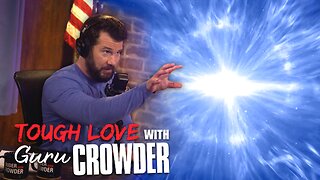Premium Only Content

Where this show is better than the New York Times (4-16-24)
Not Born Yesterday: The Science of Who We Trust and What We Believe, https://lukeford.net/blog/?p=130046
My highlights: https://lukeford.net/blog/?p=143746
New Yorker: Don’t Believe What They’re Telling You About Misinformation:
People may fervently espouse symbolic beliefs, cognitive scientists say, but they don’t treat them the same as factual beliefs. It’s worth keeping track of the difference. https://www.newyorker.com/magazine/2024/04/22/dont-believe-what-theyre-telling-you-about-misinformation
Weill isn’t the only one to fear the effects of false information. In January, the World Economic Forum released a report showing that fourteen hundred and ninety international experts rated “misinformation and disinformation” the leading global risk of the next two years, surpassing war, migration, and climatic catastrophe. A stack of new books echoes their concerns. In “Falsehoods Fly: Why Misinformation Spreads and How to Stop It” (Columbia), Paul Thagard, a philosopher at the University of Waterloo, writes that “misinformation is threatening medicine, science, politics, social justice, and international relations, affecting problems such as vaccine hesitancy, climate change denial, conspiracy theories, claims of racial inferiority, and the Russian invasion of Ukraine.” In “Foolproof: Why Misinformation Infects Our Minds and How to Build Immunity” (Norton), Sander van der Linden, a social-psychology professor at Cambridge, warns that “viruses of the mind” disseminated by false tweets and misleading headlines pose “serious threats to the integrity of elections and democracies worldwide.” Or, as the M.I.T. political scientist Adam J. Berinsky puts it in “Political Rumors: Why We Accept Misinformation and How to Fight It” (Princeton), “a democracy where falsehoods run rampant can only result in dysfunction.”
Most Americans seem to agree with these theorists of human credulity...
In a masterly new book, “Religion as Make-Believe” (Harvard), Neil Van Leeuwen, a philosopher at Georgia State University, returns to Sperber’s ideas with notable rigor. He analyzes beliefs with a taxonomist’s care, classifying different types and identifying the properties that distinguish them. He proposes that humans represent and use factual beliefs differently from symbolic beliefs, which he terms “credences.” Factual beliefs are for modelling reality and behaving optimally within it. Because of their function in guiding action, they exhibit features like “involuntariness” (you can’t decide to adopt them) and “evidential vulnerability” (they respond to evidence). Symbolic beliefs, meanwhile, largely serve social ends, not epistemic ones, so we can hold them even in the face of contradictory evidence.
https://odysee.com/@LukeFordLive, https://rumble.com/lukeford, https://dlive.tv/lukefordlivestreams
Superchat: https://entropystream.live/app/lukefordlive
Bitchute: https://www.bitchute.com/channel/lukeford/
Soundcloud MP3s: https://soundcloud.com/luke-ford-666431593
Code of Conduct: https://lukeford.net/blog/?p=125692
http://lukeford.net Email me: lukeisback@gmail.com or DM me on Twitter.com/lukeford, Best videos: https://lukeford.net/blog/?p=143746
Support the show | https://www.streamlabs.com/lukeford, https://patreon.com/lukeford, https://PayPal.Me/lukeisback
Facebook: http://facebook.com/lukecford
Book an online Alexander Technique lesson with Luke: https://alexander90210.com
Feel free to clip my videos. It's nice when you link back to the original.
-
 54:47
54:47
Steven Crowder
35 minutes agoSharpening Spiritual Tools, Handling Infidelity & Manifesting Destiny | Tough Love with Guru Crowder
93 -
 LIVE
LIVE
Major League Fishing
1 day agoLIVE Tackle Warehouse Invitationals, Stop 1, Day 1
392 watching -
 LIVE
LIVE
Bannons War Room
3 days agoWarRoom Live
16,399 watching -
 LIVE
LIVE
Matt Kohrs
9 hours agoPAYDAY FRIDAY!!! || The MK Show
1,916 watching -
 6:46
6:46
Tactical Advisor
4 hours agoHow To Make Your Dream Gun Room/Mancave
5072 -
 42:30
42:30
BonginoReport
4 hours agoThe FBI's Worst Nightmare CONFIRMED (Ep.145) - 02/21/2025
28.1K85 -
 LIVE
LIVE
Wendy Bell Radio
5 hours agoBatting 1000
12,731 watching -
![CIA EXECUTES LARGEST MASS FIRING IN 50 YEARS - HEGSETH FIRES WOKE GENERAL [EP 4448-8AM]](https://1a-1791.com/video/fwe2/78/s8/1/e/3/n/9/e3n9x.0kob-small-CIA-EXECUTES-LARGEST-MASS-F.jpg) LIVE
LIVE
The Pete Santilli Show
17 hours agoCIA EXECUTES LARGEST MASS FIRING IN 50 YEARS - HEGSETH FIRES WOKE GENERAL [EP 4448-8AM]
1,401 watching -
 1:22:46
1:22:46
Jeff Ahern
2 hours agoFriday Freak out with Jeff Ahern (Chainsawing DEI)
4.67K1 -
 46:31
46:31
PMG
13 hours agoHannah Faulkner and Mary Flynn | REVIVING THE AMERICAN DREAM - GROWING UP A FLYNN
2.35K1